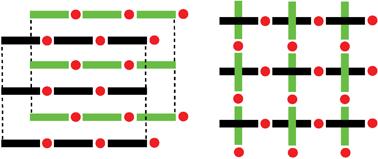The combination of bis-monodentate tectons 4 and 5, based on the dibromo fluorene backbone and bearing two pyridine units connected at positions 3 and 4, respectively, with metal halides acting as metallatectons by offering two free coordination sites leads to the formation of 1-D coordination networks in the crystalline phase as evidenced by X-ray diffraction studies on single crystal. Whereas in the case of tecton 4 and MX2 complexes (CoCl2, ZnBr2, CdBr2 and HgCl2) the zigzag type 1-D networks are packed in the classical parallel mode, for the combination of tecton 5 with HgX2
(X = Cl, Br, I) the almost orthogonal packing of the 1-D networks leads to the formation of braided sheets.
You have access to this article
 Please wait while we load your content...
Something went wrong. Try again?
Please wait while we load your content...
Something went wrong. Try again?


 Please wait while we load your content...
Please wait while we load your content...